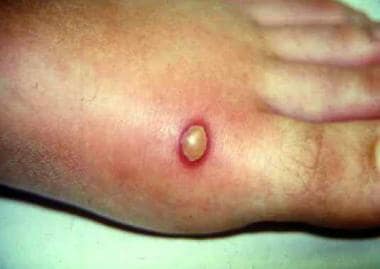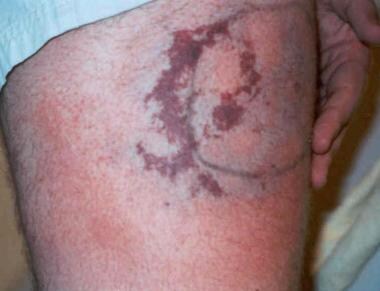History
The brown recluse spider, living up to its name, is naturally nonaggressive toward humans and prefers to live in undisturbed attics, woodpiles, and storage sheds.
Brown recluse spiders vary in size and can be up to 2-3 cm in total length. They are most active at night from spring to fall.
Characteristic violin-shaped markings on their backs have led brown recluse spiders to also be known as fiddleback spiders.
Envenomation from the brown recluse spider elicits minimal initial sensation and frequently goes unnoticed until several hours later when the pain intensifies.
An initial stinging sensation is replaced over 6-8 hours by severe pain and pruritus as local vasospasm causes the tissue to become ischemic.
Symptoms of systemic loxoscelism are not related to the extent of local tissue reaction and include the following:
-
Morbilliform rash
-
Fever
-
Chills
-
Nausea
-
Vomiting
-
Joint pain
-
Hemolysis
-
Disseminated intravascular coagulation (DIC)
-
Renal failure
-
Seizures
-
Coma
Physical Examination
Edema around the ischemic bite site produces the appearance of an erythematous halo around the lesion.
The erythematous margin around the site continues to enlarge peripherally, secondary to gravitational spread of the venom into the tissues.
Typically, at 24-72 hours, a single clear or hemorrhagic vesicle develops at the site, which later forms a dark eschar (see the image below).
 Classic finding of a vesicle with surrounding erythema at 24 hours following brown recluse envenomation. Photo by Thomas Arnold, MD.
Classic finding of a vesicle with surrounding erythema at 24 hours following brown recluse envenomation. Photo by Thomas Arnold, MD.
Necrosis is more significant in the fatty areas of the buttocks, thighs, and abdominal wall (shown in the image below).
Complications
Delayed skin grafting may be necessary after 4-6 weeks of standard therapy.
Losses of digits and amputations have been reported.
-
Classic finding of a vesicle with surrounding erythema at 24 hours following brown recluse envenomation. Photo by Thomas Arnold, MD.
-
Illustration of a brown recluse spider with the fiddle displayed prominently on its dorsum.
-
Spider envenomations, brown recluse. Envenomation site on inner thigh untreated at 1 week. Photo by Thomas Arnold, MD.
-
Typical appearance of a male brown recluse spider. Photo contributed by Michael Cardwell, Victorville, Calif.
-
Female brown recluse with size scale. Photo contributed by Michael Cardwell, Victorville, Calif.
-
Spider envenomations, brown recluse. Close-up image of dorsal violin-shaped pattern. Photo contributed by Michael Cardwell, Victorville, Calif.
-
Spider bite, brown recluse. Within an hour, the bite area swelled to the size of a quarter. The area turned blue and dark red by the evening of the first day, exceeding the boundaries of a circle drawn around the area of initial swelling by the patient's physician. Courtesy of Dale Losher.
-
Spider bite, brown recluse. The third day after the bite. The skin continues to die. Courtesy of Dale Losher.
-
Spider bite, brown recluse. Another view of the wound 3 days after the bite. Courtesy of Dale Losher.
-
Spider bite, brown recluse. Nine days after the bite. The patient endured 8 days with an open wound to drain the spider's toxins and needed multiple doses of intravenous antibiotics and pain medication. Courtesy of Dale Losher.
-
Spider bite, brown recluse. Eleven days after the bite. A 5-inch wide area of dead tissue was excised, necessitating skin grafting. Courtesy of Dale Losher.
-
Spider bite, brown recluse. Waiting to see skin graft results 38 days after the bite. Courtesy of Dale Losher.
-
Spider bite, brown recluse. Skin graft results 38 days after the bite. Courtesy of Dale Losher.
-
Spider bite, brown recluse. View of healed wound approximately 10 months after bite. Courtesy of Dale Losher.
-
Dermonecrotic arachnidism represents a local cutaneous injury with tissue loss and necrosis.
-
Brown recluse spider. Courtesy of US Centers for Disease Control and Prevention.
-
Brown recluse spider. Courtesy of US Centers for Disease Control and Prevention.
-
Complete distribution range of wild and domestic Loxosceles reclusa (brown recluse spider). Courtesy of Wikimedia Commons (By ReliefUSA_map.gif: Public domain, U.S. government derivative work: Bob the Wikipedian).










